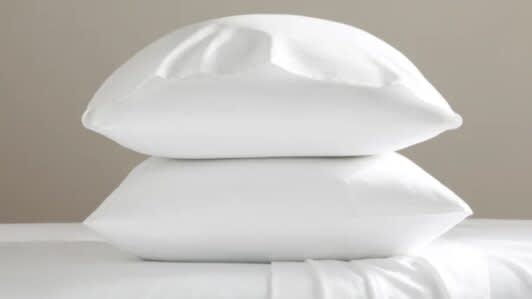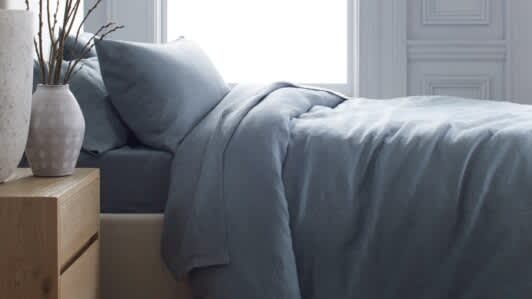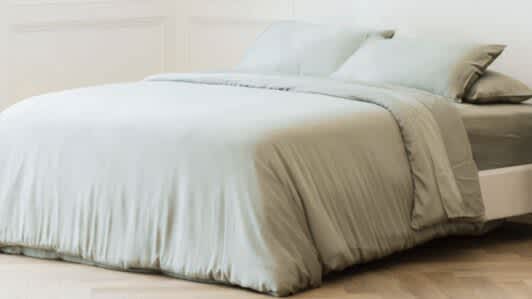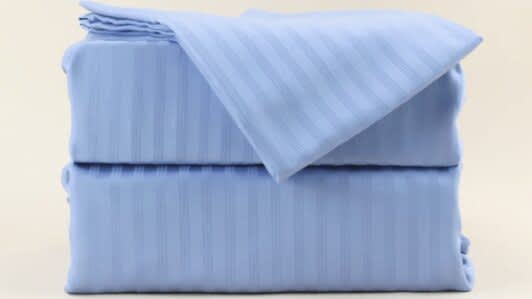On This Page
The Best Bedding of 2025
Our Top Picks
-
Best Overall
Brooklinen Classic Move-In Bundle -
Best Value
Quince European Linen Duvet Deluxe Bundle -
Best Luxury
Cozy Earth Classic Bedding Bundle -
Best for Deep Mattresses
Sheets & Giggles Bedding Bundles
Best Overall

The Brooklinen Classic Move-In Bundle includes all the pieces you need for a full bedroom setup. Each bundle includes a fitted sheet, flat sheet, four pillowcases, a duvet cover, a comforter, and two pillows. All pieces are made from high-quality materials.
Pros & Cons
Pros
- Three comforter weights and two fills to choose between
- Long-staple cotton feels crisp and breathable
- Pillows available in three fill and loft options
Cons
- Expensive pricing compared to other bedding bundles
- Not ideal for those who want smooth, silky bedding
Our Take
Best Value

Linen fabric is well known for its breathable and durable nature, though both features are typically accompanied by a hefty price tag. The Quince European Linen Duvet Deluxe Bundle offers shoppers high-quality linen bedding at an affordable price-point.
Pros & Cons
Pros
- Breathable European linen fabric
- Available in 12 colors
- Priced competitively
Cons
- Some sleepers find linen too rough on the skin
- Patterned prints cost more than solid colors
Our Take
Best Luxury

Cozy Earth’s Classic Bedding Bundle consists of viscose from bamboo fabric that’s designed to feel cooler than traditional bedding. The bundle includes a fitted sheet, flat sheet, duvet cover, and four pillow cases. Each piece is made from the same silk-like material.
Pros & Cons
Pros
- Viscose from bamboo fabric has silky-soft feel
- Designed to wick moisture and heat
- 10-year warranty that covers pilling and discoloration
Cons
- Not optimal if you prefer bedding with a crisp hand-feel
- Some patterns cost more than others
Our Take
Best for Deep Mattresses

The Sheets & Giggles Bedding Bundle allows shoppers to customize their purchase to include as many or as few bedding pieces as needed. Each bundle starts with a flat sheet, fitted sheet, and one or two pillowcases depending on which size you purchase. Those needing more pieces can add on a comforter, duvet cover, throw blanket, or extra pillowcases.
Pros & Cons
Pros
- Corner pockets accommodate mattresses up to 20 inches thick
- 360-degree elastic keeps the fitted sheet securely attached
- Eucalyptus lyocell fabric is soft and breathable
Cons
- Fabric may feel too drapey and not crisp enough for some sleepers
- Sateen-woven fabric is prone to early pilling
Our Take
How We Test
We use a combination of in-lab testing trials and user data to decide what bedding is worth your money. In our Seattle sleep lab, we examine sheets for their fabric, thread count, and weave, feeling each one in person and researching fabric production to learn how it was made. We also try out every option, lying in bed with a full sheet set to determine comfort, breathability, and overall quality. We also look to survey results and verified reviews to learn how bedding holds up over time.
How Do You Pick the Best Bedding?
Picking the best bedding starts with identifying your personal needs. Once you know what you’re looking for, it’s much easier to narrow your options. We’ll explore different types of bedding as well as how to find the best options that suit your preferences.
What Is Bedding?
Bedding is a broad category that includes multiple sleep products. These include sheets, comforters, pillows, duvet covers, and other accessories that complement your bed or mattress.
What to Look for in Quality Bedding
When comparing bedding options, several indicators of a product’s overall quality include materials, durability, warranties, and third-party certifications.
Is Quality Bedding Expensive?
Quality bedding doesn’t have to be expensive, though top-notch materials and excellent craftsmanship often cost more to manufacture than options made from lesser-quality materials.
Types of Bedding
We’ll discuss the different types of bedding available so that you know exactly what to look for when shopping for your own needs. We’ll also cover what each product is used for as well as commonly found materials.
Sheets
Sheets cover your mattress to provide a comfortable barrier between your body and the mattress’ top layer. Most sheet sets include a fitted sheet that attaches to your mattress with elastic at the corners. The corner pockets have different depths to accommodate multiple mattress profiles. A correctly placed fitted sheet wraps your mattress securely and stays in place even when sleepers switch positions.
Most sleepers use a flat sheet, or top sheet, above a fitted sheet that acts as a barrier between their skin and comforter. A top sheet can increase comfort and decrease how often you have to wash your comforter. Some people forgo a top sheet in favor of a duvet cover, which also protects your comforter.
Sheets are made from many different types of fabric, though cotton still remains the most popular choice. Cotton varies widely in cost depending on the type, thread count, and weave. Shoppers can opt for affordable fabrics like microfiber or high-end options like silk. Linen, cotton, and lyocell are plant-based fabrics that feel soft and breathable.
Your style, ideal temperature, and budget are all important factors to consider when choosing sheets.
As a hot sleeper, I look for natural fibers like cotton, bamboo, or linen because they’re inherently breathable. I also check to see if the fabric’s weave is designed for airflow or heat retention.
Pillows
High-quality pillows enhance comfort and support. Pillows come in a variety of shapes and fill options. It’s important to find a pillow with a loft, or height, designed to support your neck and keep the cervical spine in alignment while you sleep. The best pillow for you largely depends on your primary sleep position.
Some of the most popular fill options include down and down alternatives like polyfill. Foam and latex pillows are also widely used, and they work especially well for people with sensitive pressure points. In addition to traditional pillows, you also can find models designed specifically for pregnancy, CPAP masks, and supporting particular parts of the body.
Comforters
A comforter is a lofty blanket that has a shell and insulating fill. Comforters are intended to be used without a protective cover. As a result, they’re typically easier to wash than duvet inserts. Comforters come in a range of weight options. Some are meant to be used in warmer weather, while others retain heat for colder climates.
Comforter shells often consist of cotton, polyester, linen, lyocell, or microfiber. A comforter’s fill is generally airy and plush, and the actual fill material usually consists of down, down alternatives, or wool.
Since they’re most often used without a duvet cover, you can often find comforters in decorative designs and bold colors. When deciding between a comforter or duvet, consider whether you prefer using a top sheet or cover when sleeping.
Duvets
Unlike comforters, duvets are generally used in tandem with a cover. Duvet covers protect the insert and extend time between washes. Duvet inserts have a fabric shell that is typically made from a material like cotton, linen, or polyester.
Since they’re meant to be washed less often than comforters, duvet inserts may have fills made from down, wool, or silk, which typically require special care when washing. Duvet inserts aren’t usually available in patterns or designs because the shell is placed inside the duvet cover. However, duvet covers come in many different materials and colors, allowing you to change looks easily.
Quilts and Coverlets
Quilts and coverlets provide extra warmth during colder months when used as additional layers. They also provide light insulation when used as a sole blanket. Sleepers can use both options as decorative or functional pieces.
Coverlets most often consist of a single layer, while quilts have three. Quilts feature a cover, batting, and backing. These blankets get their name from the quilted stitches that keep the batting in place. Both coverlets and quilts come in trendy and classic designs that can easily enhance your bedroom’s look.
Blankets
Blanket is a general term for insulating bedding covers that add warmth, protection, and style to your bedroom. Comforters, duvets, coverlets, throw blankets, and quilts are all different types of blankets. You can also find specialty blankets, like weighted and heated options. Shoppers can purchase blankets with virtually any style or function imaginable.
Weighted and Heated Blankets
Weighted blankets have an outer shell and a fill that adds weight to the blanket. Most often, that weight comes from small beads made from glass or plastic. Some people find the hugging sensation weighted blankets provide help reduce anxiety. Generally, sleepers should use a weighted blanket that’s about 10% of their overall body weight.
Heated blankets have an electrical component that warms up to provide increased insulation. Some are meant for use between your sheets and mattress, while others are used like a traditional blanket. Heating mechanisms vary, though most have settings that let you adjust the temperature as needed.
Mattress Accessories
Mattress accessories like toppers, protectors, and skirts are also types of bedding. Mattress toppers are often made from foam, wool, or latex. They are placed on top of a mattress to increase comfort and support and extend the bed’s lifespan. You can purchase mattress toppers in firmness levels ranging from soft (3) to firm (7).
Mattress protectors either secure around your mattress like a fitted sheet or encase it completely. Both styles offer protection against wear and tear as well as dust and moisture. Bed skirts are decorative pieces of fabric that hide your box spring or bed frame. Many companies offer skirts that match their other bedding.
There are lots of organic and sustainable claims out there in the bedding world, but they’re not all trustworthy. If you want eco-friendly sheets, look for third-party certifications and choose brands with transparent sourcing and manufacturing policies.
How to Find the Best Bedding
To find the best bedding, consider a product’s fabric, construction, comfort, and durability. Next, decide whether the style of the piece you’ve chosen matches your own. There is no one-size-fits-all answer to buying the best bedding. Your individual tastes and sleep preferences will determine which products are best for your needs. We’ll provide detailed information on what to consider when deciding on what bedding to purchase.
Type of Fabric and Material
Fabric is one the most important factors to consider when purchasing bedding. Examine your own needs, then find a material to match. Those who want airy, breathable bedding should opt for plant fibers like cotton, linen, lyocell, or viscose from bamboo. Cooling-specific fibers and technology like phase change material can also help keep sleepers comfortable.
Those seeking warmer options should look to wool, brushed flannel, or plant-based fibers with dense weaves. All fabrics range in quality. Details like thread count, material origins, sustainability efforts, and manufacturer locations can all offer insight about a product’s quality.
Construction and Feel
Once you’ve settled on a type of material, you can choose the construction style you prefer. Cotton, for example, can be woven into several different kinds of fabrics. Percale sheets use a one-over-one-under weave that feels crisp and airy, while sateen sheets use one thread under and several over, which results in a silky fabric with lots of drape.
Other materials like linen and wool can also be made into fabrics with different characteristics and appearances. The density of a fabric can change its overall feel. Threads woven closely together create a tough, durable material that may not feel as soft. Conversely, loosely woven fabrics are prone to holes and pilling.
Comfort and Breathability
Plant-based fibers like linen, cotton, and lyocell tend to be highly breathable, especially when woven to allow for plenty of airflow. People who sleep hot and those in warm climates tend to favor cool bedding that doesn’t trap moisture.
Those looking for warmer options can choose brushed cotton, flannel, or microfiber, which have a soft feel. Personal preference is important when determining comfort, and shoppers should remember that their wants and needs may change throughout the seasons. Having multiple options can allow sleepers to switch bedding as needed.
Durability and Care
Bedding lifespans vary depending on how you care for the fabric as well as how durable it is. When choosing your bedding, make sure that you can adhere to the ideal care instructions and consider how often you should wash your sheets.
Washing your bedding incorrectly may ruin or damage the material. If you know you need an option that’s simple to wash, look for bedding made of material like cotton or down alternatives. Long-staple cotton and tight, durable weaves can also ensure that you’re able to use your bedding for many years. Some manufacturers provide warranties that cover pilling or defects.
Does It Fit Your Style?
Your personal style doesn’t have to be an afterthought when it comes to choosing bedding. There are a variety of options available that allow most shoppers to find bedding that suits their tastes, even if they have specific fabric or construction requirements.
In addition to physical appearance, check to see if a brand’s goals align with your own. For example, sustainably minded shoppers and those who support ethical manufacturing standards can opt to purchase bedding from a company that incorporates ethically sourced as well as organic and natural materials in their products.
How Much Does the Best Bedding Cost?
Bedding price-points vary widely depending on fabric, fiber, construction, and production practices. Typically, the longer it takes to grow, harvest, manufacture, and ship a product, the more expensive it will be. Labor regulations are different across the world and can also affect overall cost.
With so many choices on the market today, most sleepers should be able to find a complete bedding setup within their price range. Shopping sales or purchasing from direct-to-consumer brands can also help you find extra savings.
Bedding Type |
Price Range |
Budget-Friendly |
More Expensive |
Sheets |
$50-$400 |
Upland cotton or microfiber |
Egyptian cotton or silk |
Pillows |
$25-$200 |
Polyester or low-loft models |
Shredded latex or specialty body pillows |
Comforters |
$50-$500 |
Down alternatives like polyfill |
High-quality goose feather down |
Blankets |
$25-$300 |
Fleece and microfiber |
Heavy weighted blankets or hand-woven wool |
